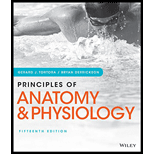
Concept explainers
On what basis are joints classified?
To review:
The basis on which the joints are classified in the human body.
Introduction:
A joint can be defined as the region of contact between the cartilage and the bone or between two bones. Flexible connective tissues hold the two or more bones together to allow movement along with better stability. These joints perform different functions based on their location and tasks.
Explanation of Solution
The joints are classified in two ways based on their structure or anatomical characteristics and function or types of movement permitted.
From a structural point of view, the joints are classified based on the kind of connective tissue, which binds the bones and the absence or the presence of the synovial cavity. Three types of joints based on the structure are as follows:
Fibrous joints: In this type, the bones are held together by the help of the dense irregular type of connective tissues that is rich in collagen fibers. There is an absence of synovial cavity in this joint type.
Cartilaginous joints: In this type, the bones are held together by cartilages. There is an absence of synovial cavity in this joint type.
Synovial joints: In this type, the bones forming the joint are encapsulated in a structure known as a synovial joint. The bones forming this joint are attached by dense and irregular type of connective tissue consisting of the articular capsule and some accessory structures like the ligaments.
From the functional point of view, the joints are classified by degree of movement permitted by the joint. The three types of joints based on the functional aspect are as follows:
Synarthrosis: In this type, the two bones are attached in such a way that there are absolutely no movements in the joint.
Amphiarthrosis: In this type, the bones are attached in such a way that the bones are slightly movable.
Diarthrosis: In this type, the bones are attached in such a way that the bones are allowed freedom of movement.
Thus, the joints are classified based on their structure and function.
Want to see more full solutions like this?
Chapter 9 Solutions
Principles of Anatomy and Physiology
- Molecular Biology Question You are working to characterize a novel protein in mice. Analysis shows that high levels of the primary transcript that codes for this protein are found in tissue from the brain, muscle, liver, and pancreas. However, an antibody that recognizes the C-terminal portion of the protein indicates that the protein is present in brain, muscle, and liver, but not in the pancreas. What is the most likely explanation for this result?arrow_forwardMolecular Biology Explain/discuss how “slow stop” and “quick/fast stop” mutants wereused to identify different protein involved in DNA replication in E. coli.arrow_forwardMolecular Biology Question A gene that codes for a protein was removed from a eukaryotic cell and inserted into a prokaryotic cell. Although the gene was successfully transcribed and translated, it produced a different protein than it produced in the eukaryotic cell. What is the most likely explanation?arrow_forward
- Molecular Biology LIST three characteristics of origins of replicationarrow_forwardMolecular Biology Question Please help. Thank you For E coli DNA polymerase III, give the structure and function of the b-clamp sub-complex. Describe how the structure of this sub-complex is important for it’s function.arrow_forwardMolecular Biology LIST three characteristics of DNA Polymerasesarrow_forward
- Molecular Biology RNA polymerase core enzyme structure contains what subunits? To form holo enzyme, sigma factor is added to core. What is the name of the structure formed? Give the detailed structure of sigma factor and the function of eachdomain. Please help. Thank youarrow_forwardMolecular Biology You have a single bacterial cell whose DNA is labelled with radioactiveC14. After 5 rounds of cell division, how may cells will contain radioactive DNA? Please help. Thank youarrow_forward1. Explain the structure and properties of atoms and chemical bonds (especially how they relate to DNA and proteins). Also add some pictures.arrow_forward
- 1. In the Sentinel Cell DNA integrity is preserved through nanoscopic helicase-coordinated repair, while lipids in the membrane are fortified to resist environmental mutagens. also provide pictures for this question.arrow_forwardExplain the structure and properties of atoms and chemical bonds (especially how they relate to DNA and proteins). Also add some pictures.arrow_forwardIn the Sentinel Cell DNA integrity is preserved through nanoscopic helicase-coordinated repair, while lipids in the membrane are fortified to resist environmental mutagens. also provide pictures for this question.arrow_forward
 Human Biology (MindTap Course List)BiologyISBN:9781305112100Author:Cecie Starr, Beverly McMillanPublisher:Cengage Learning
Human Biology (MindTap Course List)BiologyISBN:9781305112100Author:Cecie Starr, Beverly McMillanPublisher:Cengage Learning Anatomy & PhysiologyBiologyISBN:9781938168130Author:Kelly A. Young, James A. Wise, Peter DeSaix, Dean H. Kruse, Brandon Poe, Eddie Johnson, Jody E. Johnson, Oksana Korol, J. Gordon Betts, Mark WomblePublisher:OpenStax College
Anatomy & PhysiologyBiologyISBN:9781938168130Author:Kelly A. Young, James A. Wise, Peter DeSaix, Dean H. Kruse, Brandon Poe, Eddie Johnson, Jody E. Johnson, Oksana Korol, J. Gordon Betts, Mark WomblePublisher:OpenStax College Biology 2eBiologyISBN:9781947172517Author:Matthew Douglas, Jung Choi, Mary Ann ClarkPublisher:OpenStax
Biology 2eBiologyISBN:9781947172517Author:Matthew Douglas, Jung Choi, Mary Ann ClarkPublisher:OpenStax Fundamentals of Sectional Anatomy: An Imaging App...BiologyISBN:9781133960867Author:Denise L. LazoPublisher:Cengage Learning
Fundamentals of Sectional Anatomy: An Imaging App...BiologyISBN:9781133960867Author:Denise L. LazoPublisher:Cengage Learning





